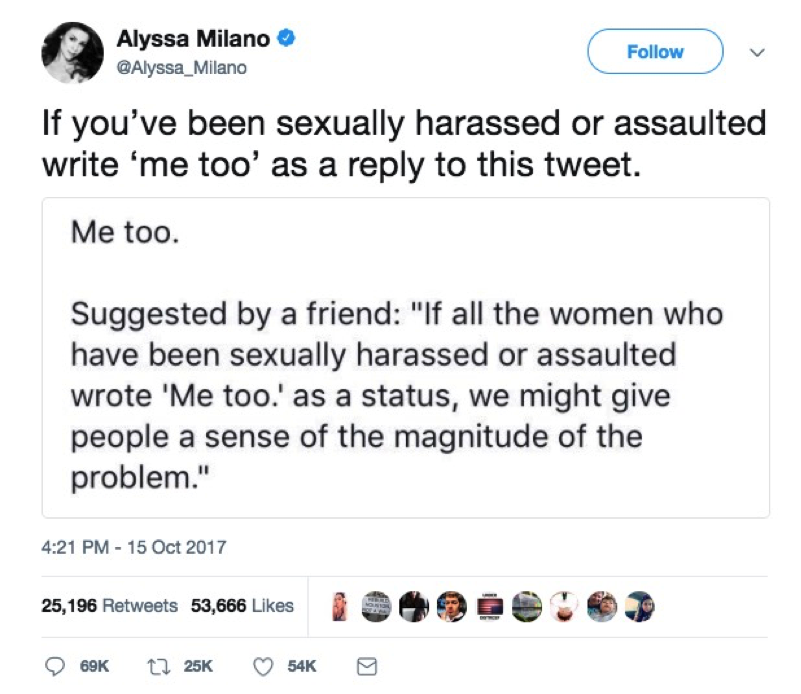“That we have found the tendency to conformity in our society so strong that reasonably intelligent and well-meaning young people are willing to call white black is a matter of concern.” -Solomon Asch
In the last lesson we talked about Garrison Keillor’s Dilemma. As you know, Garrison Keillor recently lost his job after sexual harassment allegations came to light. Since then, Senator Al Franken (D-MN), Rep. John Conyers (D-M), and Rep. Trent Franks (R-AZ) have all resigned from congress over similar accusations.
Sexual harassment is not new; public accusations are. What has changed?
Sex scandals have come and gone, but it seems that the dam burst after the Harvey Weinstein scandal. The Weinstein scandal broke on October 5, 2015. By Thanksgiving, more than one hundred similar allegations were leveled against powerful men in Hollywood, Washington, and New York.
How did social stigma morph into a social movement? On October 15th, Actress Alyssa Milano tweeted “If all the women who have been sexually harassed or assaulted wrote ‘Me too.’ As a status, we might give people a sense of the magnitude of the problem.” This was followed by a deluge of #Metoo posts on Twitter and Facebook. Women who felt that they were alone—that they had been shamed—were suddenly aware that many others have been affected, and those who spoke out made it safe for others to speak out.
The Power of Conformity
In 1951, Solomon Asch, a professor at Swarthmore College, began a series of experiments to understand the nature of conformity. Participants in the study were asked to engage in an experiment in “visual discrimination” or “visual judgment.” Students were gathered in a small group. They were asked to judge the length of a line as opposed to one of three choices. One line was correct. The other two were clearly incorrect. The experiment consisted of 18 rounds of this simple procedure. Unbeknownst to each participant, everyone else in the group was working for the experimenter. The goal was to see how the participants would handle a conflict between the pressure of the group and their own observations.
In the first two rounds, the professor’s confederates gave the correct answer. Then, the experiment began. The first confederate would choose a line that was clearly incorrect. Then the rest would agree. The participant would answer last. It might have appeared to him that the first line was correct, but he would find that giving that answer was much more challenging when everyone else answered that the second line was correct.

Ultimately, Asch found that social pressure changed participant’s answers a shocking 37% of the time.[i] This is what most people regard as the major result of the Asch experiments.
Yet, Asch also ran variations on his experiment. He subsequently found that if only two people were involved in the experiment and the confederate first chose the wrong line, the confederate’s view had little effect on the participant. When social pressure was brought to bear, however, things changed. When the experiment was run with three people (the participant and two confederates) and the two confederates first answered incorrectly, the participant also selected the wrong line 13.6% of the time. When three or more confederates unanimously chose the wrong answer, participants were swayed 31.8% of the time.[ii] Ultimately, more than one of every three participants denied their own senses, bowing to group pressure in a group of a half-dozen or more.[iii] This was all the more striking because a control group found that participants chose the wrong line less than one percent of the time when no group pressure was involved.[iv]
The Power of the Consensus Breaker
However, Asch found that the introduction of another person who told the truth strengthened the resolve of the participant. In one variation of the experiment, one of the confederates was instructed to answer truthfully, disagreeing with the majority. The results were striking. Asch wrote:
The presence of a supporting partner depleted the majority of much of its power. Its pressure on the dissenting individual was reduced to one fourth: that is, subjects answered incorrectly only one fourth as often under the pressure of a unanimous majority.[v]
In short, if one other person told the truth, that person freed the participant from the grip of social pressure. This was as important as Asch’s original findings, but it is often overlooked.
In a follow-up study twenty years later, two Dartmouth College professors conducted a similar study. They found that when a confederate who told the truth was introduced to the group, participants succumbed to the pressure only 5% of the time.[vi] As the researchers explained, “the consensus breaker may serve as a role model for resisting social pressure. The real subject may, as a result, be disinhibited and therefore not succumb to group influence”[vii]
Put another way, in the face of unanimous opposition, if just one person is willing to break the consensus, the probability that others will conform is radically altered. The odds of conformity fall from one in three to one in twenty.
Perhaps this is why we are now seeing this outbreak of women speaking out about sexual harassment and sexual assault. The men held their victims captive as long as the victims felt shame, but when the first victims spoke out, they released the others in the process, and this allowed more and more victims to come forward.
Time magazine just named the person of the year. They chose “the silence breakers”—the people who first spoke out, who freed other victims to speak, and sparked a movement.

What About You?
The implications are enormous. When you do the right thing, you stiffen the spine of others. You may not know it. They might not recognize it. Yet, the reality is that you may become a prosthetic spine for those who have become paralyzed by fear.
References
[i] Robbins, S. P., & Judge, T. O. (2015). Organizational behavior. New York: Pearson.
[ii] Asch, S. E. (1955). Opinions and social pressure. Scientific American, 193(5), 31-35.
[iii] Asch, S. E. (1956). Studies of independence and conformity: I. A minority of one against a unanimous majority. Psychological Monographs: General And Applied, 70(9), 1-70. doi:10.1037/h0093718.
[iv] Asch, S. E. (1955). Opinions and social pressure. Scientific American, 193(5), 31-35.
[v] Asch, S. E. (1955). Opinions and social pressure. Scientific American, 193(5), 31-35.
[vi] Morris, W. N., & Miller, R. S. (1975). The effects of consensus-breaking and consensus-preempting partners on reduction of conformity. Journal of Experimental Social Psychology, 11(3), 215-223. doi:10.1016/S0022-1031(75)80023-0
[vii] Morris, W. N., & Miller, R. S. (1975). The effects of consensus-breaking and consensus-preempting partners on reduction of conformity. Journal of Experimental Social Psychology, 11(3), 215-223. doi:10.1016/S0022-1031(75)80023-0. (p. 216).
-Darin Gerdes
______________

Dr. Darin Gerdes is an Associate Professor of management in the School of Business at Charleston Southern University. All ideas expressed on www.daringerdes.com are his own.
This post was originally created for Great Business Networking (GBN), a networking organization for business professionals where Dr. Gerdes is the Director of Education.
______________

